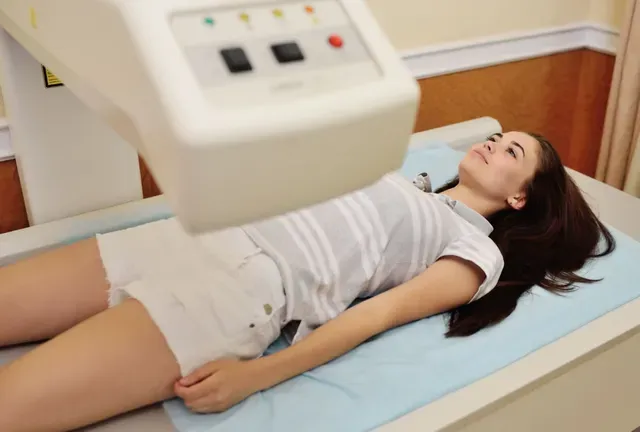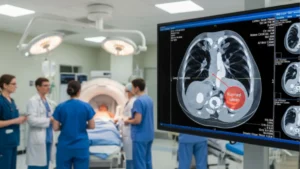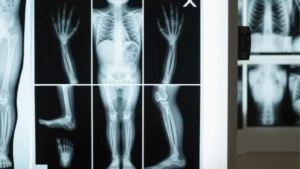The bone density test is a widely used medical procedure. It is useful in preventing disabilities of old age. If you’ve previously visited the doctor with complaints of bone pain, chances are that you may have been recommended for the test.
The bone density test is a widely used medical procedure. It is useful in preventing disabilities of old age. If you’ve previously visited the doctor with complaints of bone pain, chances are that you may have been recommended for the test.
The test is a very safe and convenient procedure. There is no physical pain associated with taking the test. It’s as simple as lying down on a bed while a physician passes a scanner over your body.
Some patients might be afraid of the test due to a lack of knowledge. But when you get to know what the test is and how it is done, you will easily snap out of any kind of fear.
What Is A Bone Density Test?
The Bone Density Test is a medical imaging technique. Doctors recommend this procedure to assess the condition of patients susceptible to bone diseases. The test score can tell the physician about the possibility of your getting a bone fracture anytime soon.
Mostly the bones of the forearm, spine, and hips are scanned during a bone density test. The results give a general idea about the amount of calcium and other minerals packed into the bone segments.
DEXA SCAN
The most common and widely recommended process of the Bone Density test is the DEXA scan. DEXA is short for “Dual-Energy X-ray Absorptiometry”. This scanning technique is the most convenient, painless, and low-cost way to detect your bone density.
DEXA scan uses two beams of very low dose X-ray. Some people might be concerned about the radiation. But the X-ray used in DEXA is ten percent of a normal chest X-ray. You are probably exposed to more radiation when you take a plane ride or sit for hours before your computer or television.
Scanning Method
A DEXA scan measures the density of your bones by passing a minute amount of x-ray beam through the target body part. The fat, bones, and other body tissues in that area will absorb the x-ray radiation.
A detector in the scanner calculates the amount of x-ray that was able to pass through the target part of your body. This information is used to create an image of the bone. Subsequently, it yields a test score.
Why Is The Bone Density Test Done?
A physician or any other healthcare provider will usually recommend the test when they find you at risk of bone disease. This suspicion might arise due to your age, gender, family history, or any symptom that indicates that something is wrong with your bones.
People over fifty and particularly women are at more risk of diseases like osteoporosis. So, you are more likely to get a bone density test when you are in that category. Early detection can save you from many major long-term complications.
Older Age
You gradually lose your bone mass as you get older. As a result, your bones become fragile every day while you are unaware of it happening. This puts you at serious risk of injury. Even a minor fall can break your bone and put you on the course of many other complications.
As the National Osteoporosis Foundation recommends, all women over the age of 65 and men over 70 should get regular DEXA scans.
Genetic Vulnerability
If your family history indicates that you are vulnerable to bone problems, then a DEXA scan is on your schedule.
This means one or more of your immediate family members suffered from osteoporosis or had several fractures.
Certain Medications
Some medications possess an established history of having adverse effects on bones. These include mainly Glucocorticoids and chemotherapy drugs in cancer treatment.
If you have recently gone through any of these treatments, your physician will give you a bone density test.
Chronic Diseases
Chronic medical conditions such as diabetes, rheumatoid arthritis, liver and kidney diseases wreak havoc on your bones.
So, anyone suffering from these diseases will need a scan to check for bone weaknesses.
Performing The Bone Density Test
The DEXA scan bone density test is a very easy procedure. You don’t need any special preparations to go through with it. Unlike other imaging techniques, they will not put you in some kind of tunnel or anything similar. There is no need to have an injection either.
There is just one thing- make sure you do not take any calcium supplements twenty-four hours before the test.
You can usually remain fully clothed when taking the test. Although this might change depending on the body part being scanned or the kind of clothes you are wearing. If your clothes have metal zippers or hooks, then you need to change into a gown for the test.
The test will go on more or less like the following:
● A medical technologist will perform the test. He or she will ask you to lie down on the special x-ray table of the DEXA scan machine. You will get help from the technologist to bring yourself to the proper position. Depending on the body part you might need foam blocks to hold the position.
● The technologist will pass the arm of the scanner over the target body part. This might be your hip, spine, or arm. The tissues in that part will absorb the low-grade x-ray beams.
● The scanners process the information it collects from measuring the bone’s density. After that, it presents the information in the form of graphs and pictures.
● You can easily recognize the bones on the computer screen from the prominent white color. Meanwhile, the muscles and other tissues are shadows in the background.
● A radiology specialist evaluates the images and determines the test score. Then the report is sent to your physician who recommended the test in the first place. Your doctor reads the report and plans further treatment.
The Meaning Of Different DEXA Test Scores
The bone density score is a Standard Deviation score. This means the score is a comparison between the density of your bones and the accepted density level of healthy bones.
Types of Scores
There are two kinds of scores in a bone density test. The T-score and the Z-score. The T score expresses the difference between the density of your bones vs. that of a healthy young adult. Whereas, the Z score expresses the difference between your measurement vs. the density of someone the same age as yours.
T Score Meanings:
If your T score is zero, it will mean you have normal bone density. Calculating from this point, negative numbers represent how much weaker your bone is from the standard density. Meanwhile, positive numbers tell how much stronger it is from the standard bone.
● Normal score: From +1 to -1
● Mildly reduced bone density: From -1 to -2.5
● Osteoporosis: less than -2.5
Z Score Meanings:
Your Z score should not go below -2. A score below -2 indicates the density of your bones is less than what it should be for a person of your age. The Z score takes into account your sex, race, height, and body weight.
However, all these scores are just an indicator of your bone health and an aid for the physician to make the perfect treatment plan. You might have a high score in bone density, but still, you can suffer a fracture if you run into some serious accident.
Conclusion
The DEXA scan bone density test is very important for people who fall into any of the risk groups. This simple, painless, and harmless test can save you from a lifetime of complications and handicaps. So, don’t hesitate the slightest if your physician recommends this test.
At One Step Diagnostic we provide Bone Density Test among many others using the latest state of the art technology performed by expert professionals. So, book an appointment now and get one step closer to fighting off that bone pain.



